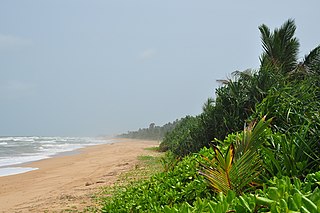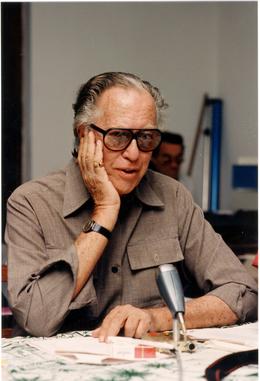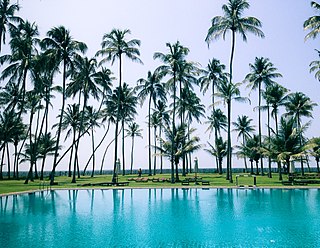
Minnette de Silva was an internationally recognised architect, considered the pioneer of the modern architectural style in Sri Lanka. De Silva was a fellow of the Sri Lanka Institute of Architects (SLIA),

Bentota is a coastal town in Sri Lanka, located in the Galle District of the Southern Province. It is approximately 65 kilometres (40 mi) south of Colombo and 56 kilometres (35 mi) north of Galle. Bentota is situated on the southern bank of the Bentota River mouth, at an elevation of 3 metres (9.8 ft) above the sea level.

Deshamanya Geoffrey Manning Bawa, was a Sri Lankan architect. Often referred to as the leader of the Tropical Modernist movement, he was among the most influential Asian architects of his generation.

The architecture of Sri Lanka displays a rich variety of architectural forms and styles. Shaivism has had a significant influence on early Sri Lankan architecture, during the reign of King Ravana, then Buddhism has also had a significant influence on Sri Lankan architecture, since it was introduced to the island in the 3rd century BCE.

The Sri Lankan Parliament Complex is a public building and landmark that houses the Parliament of Sri Lanka. Situated in Sri Jayawardenepura Kotte, the administrative capital, it is built on an island, surrounded by the Diyawanna Oya. It was designed by Deshamanya Geoffrey Bawa.
Valentine Gunasekara was a Sri Lankan architect. He became influential in his country's architecture history in the post-independent period.

William Kerry Hill was a Singapore-based, Australian architect who specialised in hotel design in tropical Asia. His works were known for their features of steeply-pitched pavilion roofs, shaded walkways, and an abundance of water features, affectionately dubbed the "Kerry Hill touch".

Justin Samarasekera was a Sri Lankan architect. He is considered to be one of the founding fathers of the architectural profession in Sri Lanka and a pioneer of architectural education in the country.
James John Ulrik Plesner was a Danish architect who has mainly worked abroad, most notably in Sri Lanka and Israel.

Major Bevis William Frederick Bawa, ADC, CLI was a Ceylonese planter, soldier and a landscaper. He was also one of the most renowned landscape architects in Sri Lanka and served as the Aide-de-camp to four Governors of Ceylon.

The Sunethra Bandaranaike House or Horagolla Stables is the country house of Sunethra Bandaranaike, renovated in the 1980s by the renowned architect Geoffrey Bawa.

Grand Oriental Hotel or GOH is a 3 star heritage hotel, located in Colombo, Sri Lanka.
Ena de Silva was a notable Sri Lankan artist, credited with re-establishing the country's batik industry. She was renowned for her skillsets in the design of batiks and handicrafts and played a pivotal role in reviving the arts and crafts in Sri Lanka.

Blue Water Hotel is a 5-star boutique hotel in Wadduwa, Sri Lanka. It is notable for being Geoffrey Bawa’s last hotel project and the last project he supervised on site before succumbing to illness.
Laki Senanayake was a Sri Lankan sculptor and painter.

Tandjung Sari is a boutique hotel located in the Sanur district of Denpasar, Bali. The hotel is considered amongst the first resorts to be built in both Sanur and Bali, and also amongst the first boutique hotels to be established in South East Asia. The hotel is founded and owned by the Waworuntu family.
Oruwala, also spelled Oruwela, was a village but is now a suburb of Colombo in the Colombo District, Western Province, Sri Lanka.
Kala Suri Barbara Sansoni was a Sri Lankan designer, artist, colourist, entrepreneur, and writer. She was known for her works in architecture, textile designs, and handwoven panels. She founded the Barefoot textile company, a company that is highly acclaimed for its handloom fabric. She also served as the chairperson and chief designer of Barefoot Pvt. Ltd for several years.

Cinnamon Bentota Beach, formerly known as Bentota Beach Hotel, is a luxury five-star hotel in Bentota, Sri Lanka. The hotel was built in 1967 and designed by Geoffrey Bawa. After refurbishment, the hotel reopened in 2019. The hotel is owned and operated by a subsidiary of John Keells Holdings under its luxury hotel chain, Cinnamon Hotels & Resorts. Cinnamon Bentota Beach is known for its architecture and decor.

Heritance Ahungalla, formerly known as the Triton Hotel, is a luxury five-star hotel in Ahungalla, Sri Lanka. Triton Hotel was designed by Geoffrey Bawa and opened in 1981. Aitken Spence Hotel Holdings is the owner and operator of the hotel. The hotel is managed as a part of Aiken Spence's Heritance Hotels and Resorts brand. Aitken Spence Hotel Holdings was incorporated in 1978 as Ahungalla Hotels Ltd and listed on the Colombo Stock Exchange in 1980. The hotel was originally named Triton Hotel after the Greek god Triton. Ahungalla Hotels Ltd became the holding company of the Aitken Spence hotel chain in 1994. The company adopted its present name, Aitken Spence Hotel Holdings, in 1997. After a US$12 million refurbishment, Triton Hotel was rebranded as Heritance Ahungalla in 2006. Heritance Ahungalla is the first five-star beach resort in Sri Lanka.

















